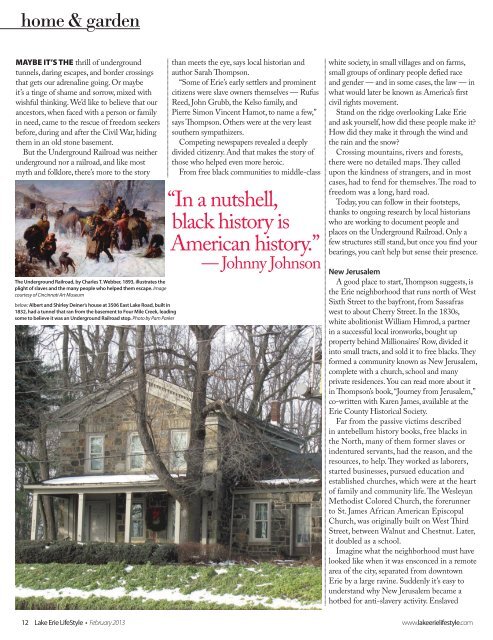Download this publication as PDF - WQLN
Download this publication as PDF - WQLN
Download this publication as PDF - WQLN
You also want an ePaper? Increase the reach of your titles
YUMPU automatically turns print PDFs into web optimized ePapers that Google loves.
home & garden<br />
MAYBE IT’S THE thrill of underground<br />
tunnels, daring escapes, and border crossings<br />
that gets our adrenaline going. Or maybe<br />
it’s a tinge of shame and sorrow, mixed with<br />
wishful thinking. We’d like to believe that our<br />
ancestors, when faced with a person or family<br />
in need, came to the rescue of freedom seekers<br />
before, during and after the Civil War, hiding<br />
them in an old stone b<strong>as</strong>ement.<br />
But the Underground Railroad w<strong>as</strong> neither<br />
underground nor a railroad, and like most<br />
myth and folklore, there’s more to the story<br />
The Underground Railroad, by Charles T. Webber, 1893, illustrates the<br />
plight of slaves and the many people who helped them escape. Image<br />
courtesy of Cincinnati Art Museum<br />
below: Albert and Shirley Deiner’s house at 3506 E<strong>as</strong>t Lake Road, built in<br />
1832, had a tunnel that ran from the b<strong>as</strong>ement to Four Mile Creek, leading<br />
some to believe it w<strong>as</strong> an Underground Railroad stop. Photo by Pam Parker<br />
February2013<br />
than meets the eye, says local historian and<br />
author Sarah Thompson.<br />
“Some of Erie’s early settlers and prominent<br />
citizens were slave owners themselves — Rufus<br />
Reed, John Grubb, the Kelso family, and<br />
Pierre Simon Vincent Hamot, to name a few,”<br />
says Thompson. Others were at the very le<strong>as</strong>t<br />
southern sympathizers.<br />
Competing newspapers revealed a deeply<br />
divided citizenry. And that makes the story of<br />
those who helped even more heroic.<br />
From free black communities to middle-cl<strong>as</strong>s<br />
“In a nutshell,<br />
black history is<br />
American history.”<br />
— Johnny Johnson<br />
white society, in small villages and on farms,<br />
small groups of ordinary people defied race<br />
and gender — and in some c<strong>as</strong>es, the law — in<br />
what would later be known <strong>as</strong> America’s first<br />
civil rights movement.<br />
Stand on the ridge overlooking Lake Erie<br />
and <strong>as</strong>k yourself, how did these people make it?<br />
How did they make it through the wind and<br />
the rain and the snow?<br />
Crossing mountains, rivers and forests,<br />
there were no detailed maps. They called<br />
upon the kindness of strangers, and in most<br />
c<strong>as</strong>es, had to fend for themselves. The road to<br />
freedom w<strong>as</strong> a long, hard road.<br />
Today, you can follow in their footsteps,<br />
thanks to ongoing research by local historians<br />
who are working to document people and<br />
places on the Underground Railroad. Only a<br />
few structures still stand, but once you find your<br />
bearings, you can’t help but sense their presence.<br />
New Jerusalem<br />
A good place to start,Thompson suggests, is<br />
the Erie neighborhood that runs north of West<br />
Sixth Street to the bayfront, from S<strong>as</strong>safr<strong>as</strong><br />
west to about Cherry Street. In the 1830s,<br />
white abolitionist William Himrod, a partner<br />
in a successful local ironworks, bought up<br />
property behind Millionaires’Row, divided it<br />
into small tracts, and sold it to free blacks.They<br />
formed a community known <strong>as</strong> New Jerusalem,<br />
complete with a church, school and many<br />
private residences. You can read more about it<br />
in Thompson’s book,“Journey from Jerusalem,”<br />
co-written with Karen James, available at the<br />
Erie County Historical Society.<br />
Far from the p<strong>as</strong>sive victims described<br />
in antebellum history books, free blacks in<br />
the North, many of them former slaves or<br />
indentured servants, had the re<strong>as</strong>on, and the<br />
resources, to help. They worked <strong>as</strong> laborers,<br />
started businesses, pursued education and<br />
established churches, which were at the heart<br />
of family and community life. The Wesleyan<br />
Methodist Colored Church, the forerunner<br />
to St. James African American Episcopal<br />
Church, w<strong>as</strong> originally built on West Third<br />
Street, between Walnut and Chestnut. Later,<br />
it doubled <strong>as</strong> a school.<br />
Imagine what the neighborhood must have<br />
looked like when it w<strong>as</strong> ensconced in a remote<br />
area of the city, separated from downtown<br />
Erie by a large ravine. Suddenly it’s e<strong>as</strong>y to<br />
understand why New Jerusalem became a<br />
hotbed for anti-slavery activity. Enslaved<br />
www.lakeerielifestyle.com


